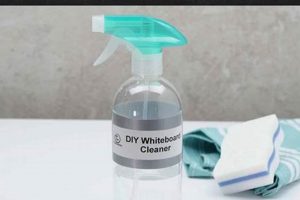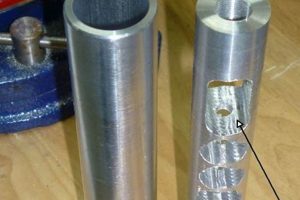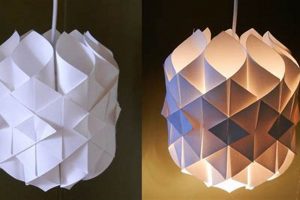Constructing one’s own supports and mechanisms for window coverings represents an avenue for customization and cost savings in interior design. This approach allows for tailoring components to fit specific window dimensions, aesthetic preferences, and functional requirements. Examples include crafting rods from plumbing pipes, utilizing repurposed materials for brackets, and creating unique pulley systems for raising and lowering fabric panels.
The advantages of this approach are multifaceted. Financial gains are realized by minimizing expenses associated with purchasing pre-fabricated items. Furthermore, the practice encourages creative problem-solving and resourcefulness, resulting in personalized solutions not readily available through commercial channels. Historically, individuals frequently relied on self-sufficiency to outfit their homes, a tradition that finds renewed relevance in contemporary interest in sustainable and individualized living spaces.
The subsequent sections will delve into specific techniques for fabricating various elements, covering rod creation, bracket assembly, and innovative methods for achieving smooth and reliable operation. These methodologies empower individuals to take control of their window treatment installations and achieve desired outcomes with readily accessible materials and tools.
Essential Considerations for Fabricating Custom Window Treatment Supports
The following recommendations offer guidance for individuals undertaking the design and construction of personalized mechanisms for window coverings. Adherence to these principles can promote safety, functionality, and aesthetic appeal.
Tip 1: Material Selection. Prioritize durable and appropriately weighted materials. Metal pipes, solid wood, and reinforced composites are suitable options for rods. Consider the weight of the intended fabric when making material choices to prevent sagging or structural failure.
Tip 2: Precise Measurement. Accurately measure window dimensions and desired curtain length before commencing construction. Account for overlap beyond the window frame for enhanced light blockage and privacy.
Tip 3: Secure Mounting. Ensure brackets are securely affixed to the wall or window frame using appropriate anchors and fasteners. The type of wall construction (e.g., drywall, plaster, concrete) dictates the appropriate hardware. Verify load-bearing capacity to avoid detachment or instability.
Tip 4: Smooth Operation. Implement mechanisms that facilitate smooth and effortless opening and closing of the curtains. Consider incorporating low-friction glides or rings to minimize resistance and prevent snagging.
Tip 5: Aesthetic Considerations. Pay attention to the visual harmony between the fabricated components and the existing interior decor. Select finishes, colors, and styles that complement the overall design scheme. Experiment with decorative elements to personalize the installation.
Tip 6: Safety Precautions. When working with power tools or hazardous materials, adhere to all safety guidelines. Wear appropriate protective equipment, such as safety glasses and gloves. Ensure adequate ventilation to avoid exposure to fumes or dust.
Tip 7: Level Installation. Employ a level to ensure that the rod and brackets are perfectly horizontal. Misalignment can result in uneven curtain hanging and an aesthetically displeasing appearance.
Tip 8: Weight Distribution. If using multiple brackets, ensure even weight distribution to prevent stress on individual mounting points. Space brackets appropriately based on the length of the rod and the weight of the curtains.
By incorporating these recommendations, individuals can successfully create functional and aesthetically pleasing window covering supports that enhance the interior environment while reflecting personal style and ingenuity.
The next section will explore common challenges encountered during the construction process and offer solutions for overcoming them.
1. Material Strength
Material strength directly influences the functionality and longevity of any self-constructed window covering support system. The ability of the chosen materials to withstand stress and weight dictates the overall performance and safety of the installation. Insufficient strength can lead to sagging, bending, or even complete failure of the structure, particularly under the weight of heavy drapes or curtains. A failure might manifest as a rod collapsing under the accumulated weight of velvet curtains, or brackets detaching from the wall due to insufficient load-bearing capacity. Understanding the material properties and their capacity to endure specific loads is, therefore, a primary consideration.
Different materials offer varying degrees of strength and suitability. Steel, for instance, possesses high tensile strength, making it an appropriate choice for supporting substantial weight over extended spans. Wood, while aesthetically pleasing, may require reinforcement or a larger cross-section to achieve comparable strength, particularly if sourced from softwood species. Plastic, typically lighter and less expensive, is often inadequate for supporting heavy fabrics and may be prone to deformation over time. Real-world applications demonstrate this distinction; a repurposed metal pipe serves as a robust curtain rod, while a thin plastic rod would quickly buckle under similar conditions. Proper selection depends on an evaluation of both aesthetic preferences and structural demands.
In conclusion, the correlation between material strength and the successful creation of window treatment supports cannot be overstated. Careful consideration of load requirements, coupled with informed material selection, is essential for ensuring a safe, functional, and visually appealing outcome. Failure to address this critical aspect can result in structural instability, premature failure, and ultimately, the need for costly repairs or replacements. Therefore, a thorough assessment of material properties is paramount for those undertaking these projects.
2. Bracket Integrity
The structural soundness of brackets is paramount when constructing window treatment supports. These components bear the entire load of the rod and fabric, directly influencing the stability and safety of the entire assembly. Compromised integrity, stemming from deficient materials, inadequate construction, or improper installation, can lead to catastrophic failure. This, in turn, results in damage to the surrounding environment, potential injury, and the need for immediate remedial action. A bracket crafted from brittle material, or one that employs insufficient fasteners, risks detachment from the wall. Such an event may cause the rod and curtains to fall, potentially damaging furniture, striking individuals, or otherwise disrupting the intended function of the space. Therefore, the selec
tion of robust materials and the implementation of secure fastening techniques are indispensable to the long-term performance of any window treatment installation.
Considerations extend beyond material selection and fastening methods. The design of the bracket itself contributes significantly to its load-bearing capabilities. Brackets with well-engineered support structures and strategic reinforcement are better equipped to distribute weight evenly and resist bending or deformation. For instance, a bracket incorporating a gusset, or a triangular brace, provides enhanced rigidity and prevents the bracket from flexing under heavy loads. Furthermore, the type of wall to which the bracket is affixed dictates the appropriate anchoring system. Drywall requires specialized anchors designed to grip the material effectively, while solid wood or concrete necessitates different types of fasteners for optimal hold. Neglecting these factors can result in compromised stability, even with otherwise robust components. A common issue is brackets tearing away from the wall due to improper screw length or unsuitable anchor type.
In summary, ensuring the solidity of support elements is central to the creation of reliable systems for window coverings. Careful attention to material selection, design principles, appropriate fastening methods, and adaptation to specific wall conditions is essential for mitigating the risk of failure and guaranteeing long-term stability. The investment in quality materials and meticulous installation techniques translates directly to the enhanced safety, functionality, and aesthetic appeal of the finished window treatment. Ignoring these critical aspects undermines the entire project, potentially leading to costly repairs and safety hazards.
3. Rod Diameter
The selection of an appropriate rod diameter is a fundamental consideration in the design and construction of customized window treatment support systems. This dimension directly impacts the structural integrity, functionality, and visual balance of the installation, influencing both its performance and aesthetic appeal. Insufficient diameter can lead to bending, sagging, or even complete failure, while excessive diameter may create a disproportionate and visually unappealing effect.
- Load-Bearing Capacity
Rod diameter significantly affects load-bearing capacity. A larger diameter inherently provides greater resistance to bending and deformation, making it suitable for supporting heavier fabrics or wider window spans. Conversely, a smaller diameter rod may suffice for lightweight sheers or narrow windows. For example, a one-inch diameter steel pipe may adequately support heavy velvet drapes, while a half-inch diameter rod might bend under the same load. Neglecting this facet can result in structural instability and eventual collapse.
- Aesthetic Proportionality
The diameter must be visually proportionate to the window size and fabric weight. A thin rod on a large window appears flimsy and inadequate, while an overly thick rod on a small window appears cumbersome and overpowering. A balanced aesthetic requires careful consideration of the rod’s visual presence relative to its surroundings. A general guideline is to select a diameter that complements the overall design and avoids drawing undue attention to itself.
- Curtain Hardware Compatibility
Rod diameter dictates the compatibility of curtain rings, grommets, or other hardware used to attach the fabric. Selecting the wrong diameter may render the chosen hardware unusable, requiring a change in design or a compromise in functionality. For instance, curtain rings designed for a one-inch rod will not function properly on a half-inch rod. Verifying compatibility before commencing construction is essential to avoid logistical challenges and aesthetic discrepancies.
- Material Rigidity
Different materials exhibit varying degrees of rigidity, impacting the required diameter. A less rigid material, such as wood, may necessitate a larger diameter to achieve the same load-bearing capacity as a more rigid material, such as steel. Choosing a softer wood may result in choosing a larger rod diameter. Understanding the inherent properties of the selected material is crucial for determining the appropriate dimensions and ensuring structural integrity.
In conclusion, rod diameter is an essential factor in the construction of window treatment supports. Careful consideration of load-bearing capacity, aesthetic proportionality, hardware compatibility, and material rigidity is necessary for achieving a functional, visually balanced, and structurally sound installation. A failure to adequately address these facets can result in compromised performance, aesthetic inconsistencies, and potential structural failures, undermining the overall effectiveness of the system.
4. Finish Durability
The longevity and aesthetic appeal of self-constructed window treatment supports are inextricably linked to the resilience of their applied finishes. For components crafted from materials susceptible to corrosion, oxidation, or environmental degradation, the implementation of a durable coating becomes a necessity, not merely an aesthetic consideration. The absence of a robust finish precipitates premature deterioration, diminishing the structural integrity and visual appeal of the installation. For instance, an untreated steel rod exposed to moisture will rapidly develop rust, compromising its strength and leaving an unsightly residue on adjacent fabrics. Conversely, a properly finished rod, utilizing powder coating or multiple layers of protective enamel, can withstand years of exposure without significant degradation.
Practical applications illustrate the significance of finish durability across diverse material choices. Wood, although less prone to corrosion, is susceptible to moisture damage, warping, and infestation. The application of varnish, lacquer, or sealant provides a barrier against these threats, preserving the integrity of the wood and enhancing its natural beauty. Similarly, copper or brass components, while aesthetically pleasing in their raw state, can develop a patina over time. Whether this patina is desirable is a matter of personal preference, but without protective measures, the oxidation process is accelerated and uncontrolled. A durable clear coat can prevent this undesired oxidation, preserving the original luster. Moreover, finish durability directly impacts maintenance requirements. Components with robust finishes require less frequent cleaning and repair, reducing the overall cost and effort associated with their upkeep.
In summary, the correlation between finish durability and the sustained performance of “diy curtain hardware” is undeniable. Neglecting this aspect results in compromised longevity, increased maintenance, and diminished aesthetic appeal. By prioritizing the selection and application of durable finishes, individuals can significantly extend the lifespan of their creations, ensuring both functionality and visual satisfaction for years to come. The challenges inherent in achieving optimal finish durability lie in selecting appropriate materials, employing proper application techniques, and adapting to the specific environmental conditions to which the hardware will be exposed. These considerations, however, are essential for realizing the full potential of self-constructed window treatment systems.
5. W
eight Capacity
Weight capacity is a critical parameter in the realm of self-assembled window treatment infrastructure. This attribute dictates the maximum load a self-constructed system can safely bear, directly influencing its functionality and longevity. Exceeding this limit initiates a chain of events, beginning with structural strain and culminating in potential system failure. Such failure poses a hazard, potentially causing damage and necessitating costly repairs or complete replacements. The selection of materials, the design of brackets, and the integrity of fasteners directly contribute to the overall weight-bearing capability. For example, a system utilizing thin-walled PVC pipes and lightweight plastic brackets is inherently limited in its weight capacity, suitable only for sheer fabrics or lightweight curtains. Conversely, a system employing thick-gauge steel pipes and robust metal brackets exhibits a significantly higher weight capacity, enabling the support of heavier drapes and blackout curtains. Misjudging this parameter can lead to catastrophic consequences.
The practical significance of understanding weight capacity extends to various aspects of the project. Informed material selection becomes paramount; the mechanical properties of chosen components must align with the anticipated load. Bracket design must incorporate principles of load distribution and structural reinforcement, preventing localized stress concentrations. Fastener selection necessitates the consideration of shear strength and pull-out resistance, ensuring secure attachment to the supporting structure. For instance, a bracket intended to support heavy drapes requires the use of lag screws anchored into wall studs, rather than relying on drywall anchors which offer insufficient holding power. Furthermore, the spacing of support brackets must be strategically determined to prevent sagging or bending of the rod, particularly over extended spans. Failure to account for these factors can lead to gradual deformation of the system over time, culminating in eventual collapse. Examples of neglecting weight capacity requirements are commonplace, ranging from bent rods to brackets tearing away from the wall.
In summary, an accurate assessment of weight capacity is indispensable for the successful fabrication of window treatment systems. The consequences of underestimation extend beyond mere inconvenience, potentially resulting in structural failures and safety hazards. A comprehensive understanding of material properties, bracket design principles, and fastener selection criteria, coupled with meticulous attention to detail, ensures the creation of a system that meets both functional and aesthetic requirements while maintaining long-term reliability. While challenges exist in accurately calculating weight loads and material strengths, adherence to established engineering principles and a conservative approach mitigate the risks associated with self-constructed systems.
6. Smooth Operation
The functional efficacy of self-constructed window treatment systems is intrinsically linked to the ease with which the window coverings can be opened and closed. This attribute, designated as “smooth operation,” influences the user experience and contributes to the overall satisfaction derived from the installation. Impediments to smooth operation can render a system cumbersome and detract from its intended purpose, thereby undermining the investment of time and resources.
- Friction Reduction
Minimizing friction between moving components is fundamental to achieving smooth operation. Friction manifests as resistance to movement, requiring increased effort to manipulate the window coverings. Common sources of friction include contact between curtain rings and the rod, fabric rubbing against the brackets, or misalignment of the rod. Solutions include utilizing low-friction curtain rings constructed from materials such as nylon or Teflon, ensuring proper alignment of all components, and applying lubricant to friction points. Neglecting friction reduction can lead to jerky or uneven movement, premature wear of components, and increased user effort.
- Component Alignment
Precise alignment of all elements in the system is essential for unrestricted movement. Misalignment can create binding points, impeding the smooth traversal of the curtains along the rod. This issue frequently arises from improperly installed brackets or variations in rod straightness. Correction involves careful measurement, precise installation techniques, and the use of shims or spacers to achieve optimal alignment. Failure to address misalignment results in increased friction, uneven curtain distribution, and potential damage to the fabric or hardware.
- Weight Distribution
Even distribution of weight along the rod prevents localized stress and promotes smooth, consistent movement. Uneven weight distribution can cause sagging, binding, and increased friction in specific areas. This issue is particularly prevalent in systems supporting heavy fabrics or traversing long window spans. Solutions involve employing multiple support brackets strategically positioned along the rod and selecting materials with sufficient rigidity to resist bending under load. Neglecting weight distribution leads to inconsistent operation, premature wear of components, and potential structural failure.
- Hardware Selection
The choice of appropriate hardware, including curtain rings, glides, and tracks, directly impacts the operational smoothness of the system. Incompatible or poorly designed hardware introduces unnecessary friction and resistance. Curtain rings should move freely along the rod without binding or snagging. Glides, when employed, should provide smooth and consistent movement within the track. The selection of hardware should be based on fabric weight, rod diameter, and desired functionality. Using the wrong hardware can cause snagging, uneven movement, and increased effort.
The integration of these principles directly impacts the user experience and determines the long-term success of self-constructed window treatment systems. Systems exhibiting smooth operation provide effortless functionality, enhance the aesthetic appeal of the space, and contribute to overall user satisfaction. Conversely, systems characterized by friction, binding, or uneven movement detract from the intended purpose and necessitate remedial action. Therefore, prioritizing smooth operation during the design and construction process is essential for realizing the full potential of self-constructed systems.
Frequently Asked Questions
The following questions address common inquiries and misconceptions regarding the design and fabrication of personalized window treatment systems. The aim is to provide clarity and informed guidance for individuals undertaking such projects.
Question 1: What is the most critical factor to consider when selecting materials for DIY curtain hardware?
Material selection hinges upon the anticipated load. The chosen material must possess sufficient strength and rigidity to support the weight of the window coverings without bending or sagging. Steel, solid wood, and reinforced composites are viable options, provided their load-bearing capacity aligns with the intended application.
Question 2: How can one ensure that brackets are securely mounted to the wall? em>
Secure mounting necessitates the use of appropriate anchors and fasteners tailored to the specific wall construction. Drywall requires specialized anchors designed to grip the material effectively, while solid wood or concrete demands different fastening methods. Verifying load-bearing capacity is crucial to prevent detachment or instability.
Question 3: What steps can be taken to achieve smooth operation of the curtains?
Smooth operation relies on minimizing friction between moving components. Utilizing low-friction curtain rings, ensuring proper component alignment, and applying lubricant to friction points are effective strategies. Selecting compatible hardware and maintaining even weight distribution along the rod further contribute to seamless movement.
Question 4: How does rod diameter influence the overall performance of the system?
Rod diameter directly impacts load-bearing capacity and aesthetic proportionality. A larger diameter provides greater resistance to bending, making it suitable for heavier fabrics. However, the diameter must also be visually proportionate to the window size and fabric weight to maintain aesthetic balance.
Question 5: What measures can be implemented to protect the hardware from environmental degradation?
Finish durability is paramount for preserving the hardware’s integrity. Applying protective coatings, such as varnish, lacquer, or sealant, shields the materials from moisture, corrosion, and oxidation. Regular maintenance and cleaning further extend the lifespan of the finish.
Question 6: How is the overall weight capacity of the support system calculated?
Determining the weight capacity involves assessing the combined weight of the rod, curtains, and any additional hardware. The material properties of the rod and brackets, along with the strength of the fasteners, dictate the maximum load the system can safely support. Consulting engineering guidelines or seeking professional advice is recommended for complex installations.
In conclusion, careful consideration of material selection, mounting techniques, operational mechanics, and environmental factors is essential for successfully constructing custom window treatment supports. Adherence to these principles promotes functionality, durability, and aesthetic appeal.
The next section will provide a summary of key considerations for ensuring the longevity and performance of self-constructed systems.
Conclusion
This exploration of DIY curtain hardware underscores the importance of meticulous planning and execution in achieving successful and enduring results. Material selection, bracket integrity, rod diameter, finish durability, weight capacity, and operational smoothness have been identified as critical determinants of system performance. Neglecting these factors compromises functionality, aesthetics, and safety. The construction of window treatment supports is not merely a cost-saving endeavor, but a project demanding careful consideration of structural principles and material properties.
The pursuit of customized window solutions should prioritize informed decision-making and adherence to established engineering guidelines. By recognizing the significance of each element, individuals can create systems that not only meet their functional requirements, but also enhance the aesthetic appeal of their living spaces. The enduring value of DIY curtain hardware lies in its potential to provide personalized, durable, and aesthetically pleasing solutions, provided that the undertaking is approached with diligence and a commitment to quality.







